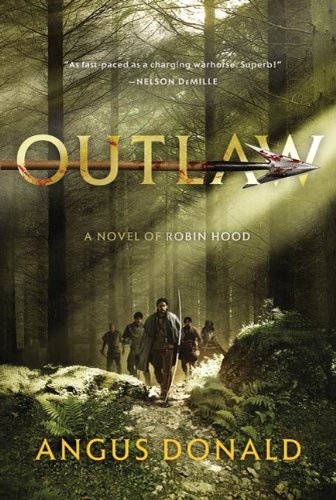Swords and Plumes 002: Revisionist Robin Hoods #1
 Outlaw: A Novel of Robin Hood, by Angus Donald. St. Martin’s Griffin, 2011; reviewed in the trade paperback edition.
Outlaw: A Novel of Robin Hood, by Angus Donald. St. Martin’s Griffin, 2011; reviewed in the trade paperback edition.
The Robin Hood ballads date back to at least the early Renaissance, and probably existed in oral tradition much earlier than that. The stories were revived during the Romantic movement of the early 19th century by Sir Walter Scott and Pierce Egan the Younger (one of Egan’s tales will be included in The Big Book of Swashbuckling Adventure), then perpetuated by Howard Pyle, Henry Gilbert, and other writers into the early 20th century. By the dawn of the silent movie era the image of Robin Hood the daring rogue was well established in the public mind, and he made a seamless transition to cinema, most successfully in the 1922 feature starring Douglas Fairbanks Sr. The climax of this swashbuckler phase was 1938’s The Adventures of Robin Hood, in which Errol Flynn defined the character for the next two generations of books, comics, movies, and television series.
By the 1970s the legend was ripe for reimagining, and the ball really got rolling with the 1976 movie Robin and Marian, the first important entry in what I call “Revisionist Robin Hoods.” James Goldman’s story, directed by Richard Lester (The Three Musketeers and The Four Musketeers), placed Robin squarely in the brutal historical reality of the Third Crusade. An aging Robin Hood (played pitch-perfectly by Sean Connery) returns from the Holy Land to find himself caught up in his own legend. He resumes his bittersweet romance with Marian, as well as his deadly rivalry with the Sheriff of Nottingham, and the inevitable result is mayhem, death, and tears.
Since then there has been a steady flow of Revisionist Robin Hoods, in both books and movies, with no sign of it stopping anytime soon. We’re no longer able to accept Robin and his Merrie Men as a jolly gang of innocent do-gooders on a happy campout in Sherwood Forest, so “gritty realism” is the order of the day. This, on the whole, is No Bad Thing, and Angus Donald’s novel Outlaw clearly shows that the genre is not yet worked out.
The protagonist of Outlaw is a young peasant thief named Alan Dale, caught for robbery and sentenced to lose a hand, who flees into the greenwood to join Robin and his band. Donald’s portrayal of Sir Robert Odo aka Robin Hood as a charismatic but ruthless renegade knight is convincing, and the author’s portrayal of the hard life of a band of medieval outlaws rings true. Robin’s band is leavened with a cadre of ex-soldiers who train the outlaws in the use of pole-arms and the Welsh longbow, and they become a force that can credibly stand against the footmen and mounted knights the Sheriff sends after them. The author has done his homework, and his depiction of the bloody work of combat in the 12th century is in equal parts thrilling and horrific.
Alan Dale’s father was an itinerant troubadour, and Alan has inherited his musical talents, so he becomes the outlaw band’s bard. Also on hands are Donald’s versions of Robin’s right-hand-man John, Tuck the Friar, Much Millerson, Robin’s love Marian – Marie-Anne of Locksley in this retelling, a high-born maiden who takes the story out of the woods and into the Royal Court for some political intrigue.
The basic conflict is between downtrodden Saxons and oppressive Normans, a trope that became common to the Robin Hood legend starting with Walter Scott’s 1819 novel Ivanhoe. Of course, in Outlaw not all the Normans are bad and not all the Saxons are good, but Donald’s Sir Ralph Murdac, the Sheriff of Nottingham, is as arrogant and epicene as any nasty Norman noble out of Egan, Scott, or Pyle. He’s a villain who needs killin’.
Donald also avails himself of another, more recent addition to the legend: his Robin Hood is so bitterly opposed to the aristocratic establishment that he renounced Christianity and revives the Druidic worship of Cernunnos, and deep in the woods he leads his followers in ancient pagan rituals. Friar Tuck, as you might imagine, has some issues with this.
The book is fast-paced, the characters are memorable and well-drawn, and the dialogue is crisp and modern. The novel’s climax is an exciting set-piece battle between Robin’s eclectic forces and the Sheriff’s knights and mercenary men-at-arms, with sudden but believable reversals of fortune leading up to a satisfying ending. It has a sequel, Holy Warrior, in which Robin and his men follow King Richard to the Crusades. Watch this space for a review in a future posting.
“Outlaw” is available from Amazon in trade paperback, Kindle download, and unabridged Audible download formats.